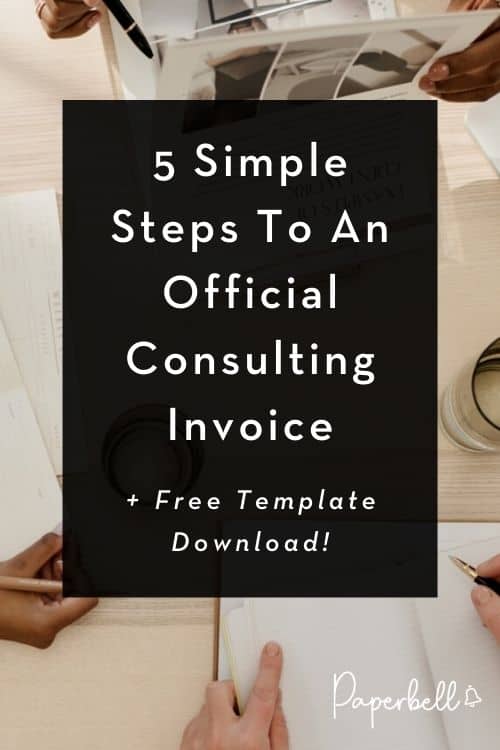So, here you are. You’ve put together a killer pitch, your first client went for it, you delivered the work like a pro, and now it’s time to get paid. Whoop!
But…how?
Issuing your first consulting invoice as an independent consultant may seem tricky at first, but with the help of our free consulting invoice template, it should be a breeze. After your first few invoices, billing for your consulting business will be second nature, but just in case, you can always bookmark this page and come back to it for a cross-check.
Let’s look at everything you need to include in your consulting invoice in detail and how it should look in the end. We’ll also share some of our best ninja tricks for invoicing in this article so that you can skip the rookie mistakes and get paid on time (or even in advance…)
Ready? Let’s go.
Note: The information we gathered in this article should not be considered legal advice. If you need professional legal advice, please consult with a lawyer.
8 Things Your Consulting Invoice Should Include
Your Contact Information
All valid professional invoices need to contain your full name or company name as it is registered and your full address or business address. Preferably, to avoid confusion, it should also list your direct contact information, such as your business email address or phone number. Even if your client already has it, it still comes in handy in case their assistant or finance department needs to contact you for anything.
If you have a business registered in the European Union and you’re billing to another EU business or entrepreneur, make sure you also include your EU tax number as per regulations.
Your Client’s Contact Information
Just the same, you’ll need to list the client’s information – the full name or business name of the client you’re invoicing your consulting services to, as well as their full address. Preferably, include the email address of your client too.
If both of you are located in the EU, you’ll need to include the tax number of your client as well.
Invoice Number
For your invoice to be valid, it needs to have an assigned number. Technically this can be any serial number distinct from all other invoices you’ve issued in the past or will issue in the future for clear differentiation.
There are different practices to assigning numbers to your invoices and keeping them neatly organized, but the easiest way is to use the year the invoice is being issued followed by a sequential number that will change on every invoice you issue that year. So if you’re issuing an invoice in 2022, you can assign the invoice number 2022-01 to your first invoice, then 2022-02 to your next, and so on.
Some consultants prefer to assign a number to each of their clients so they can keep track of how many invoices they’ve billed to the same client’s company. For example, client number three may be billed with the number #03-001. Either way, your numbering system should be consistent, so you (or your accountant) won’t be losing sleep next year declaring your taxes and running your yearly revenue audit.
Invoice Date
Your invoice date or issue date should be the day when you’re issuing your invoice for your client. Some invoices list the completion date separately (the day when the work was completed), but it’s optional.
The other important date you should have on your invoice is the due date (or the deadline, if you will) for your client to settle the payment. The time between the issue date and the due date depends on the payment terms you set with your client, which should be written in your contract with them. Your invoice due date will also be important as a reference in cases when you charge late payment fees.
Services Billed
Here’s where you can list all services you delivered as per your agreement. Be as specific as you can when naming them; for example, instead of stating “consulting meeting,” say “strategy consultation on the Manhattan project — Part I.”
Beside each item, mark the billing rate, billable hours, or unit price, which is either your hourly fee or the flat fee for the deliverable. Then calculate the actual amount payable for each of these service items, in other words, your net price. If you charge by your time, make sure you include all trackable billable hours, so you don’t get short-changed for your consulting work.
If you charge VAT on your services, list that separately as well for each. Note that this is not a personal preference but something that’s determined by tax regulations in your country. Check the correct applicable taxes for the country you are invoicing from.
Make sure you include the currency of the payment as well, even if you’re working with a local client. Free services, such as your initial complimentary consultation, can be listed here as well, but they aren’t compulsory.
Below all of the services listed on your bill, you should include the total amount billed, even if you list only one item.
Payment Terms and How to Pay
It’s surprising how many consultants submit an invoice without a way to get paid! Your payment terms are important! How many days does your client have to pay you? What online payment methods can they use to send you the money for your consulting services?
If you’re using Paperbell, your clients will pay you by credit card right from the link you send them. Otherwise, make sure to include your full bank details or a link to pay by credit card.
Notes
Normally, your additional notes go to the bottom of the page. Was there something your client specifically requested to be included on the invoice? Add it here.
Here is also where you can add further information about your account details and how you accept payments (if you haven’t included this in your personal details already), any notes relevant to taxation, or just a personal note such as “Thank you for your business!”
Consulting Invoice Template for Independent Contractors
If you’re wondering how to create an invoice for consulting work, we’ve got you covered with the below sample consulting invoice. Just copy and paste, add your company logo, send it to your clients, and get paid in no time!

Use this invoice template for your consulting invoice; it’s easily customizable, so you can get paid for your consulting work asap:
Invoice No 2022-01
From:
Colin Consultancy Ltd.
56893 Jamestown
Freeway Avenue 67.
Phone: +1122334455
Email: colin@consultancy.com
To:
Major Corporate Ltd.
82654 Bayland
Belle Ville Road 3
Email: major@corporate.com
Completion date: 2/2/2022
Issue date: 2/2/2022
Due date: 9/2/2022
Description: Strategy consultation on the Manhattan project — Part I
Quantity: 1
Unit Price: $1000
Net Price: $1000
VAT: N/A
Gross Price: $1000
Total: $1000
Notes: Please settle payment to colin@consultancy.com via PayPal. Thank you for your business!
Google Docs Consultant Invoice Template
Here’s a Google Doc template you can use for your consulting invoice. Just go to File > Download to edit this Google Docs consulting invoice template. If you need more flexibility, an Invoice Template for Google Docs & Sheets can also help you create professional invoices quickly.
You can fill in the invoice template, save it as a PDF and send it directly to your client. Not sure what to write in the email to your client? Check out this post.
Although in our opinion, there’s a much better way you can request payments from clients that lets you skip the manual paperwork and follow-up emails altogether…
Manage Your Packages & Invoices With Paperbell
When you’re working as a consultant, invoicing is one of those boring items on your to-do list that eats up way too much time. It often takes multiple follow-up emails for a client to pay when you could really use that time to actually work with your clients instead.
What if you could automate invoice writing, sending over payment terms, and doing boring admin? With Paperbell, you just send your clients one link to your package, where they will make the payment instantly – whether that’s a one-time payment, payment for a payment plan, or ongoing subscription payment. You can also manage all your appointment scheduling, contracts, surveys, and all other client admin in one place.
Set up a free account here to test out all of the features.
5 Tips for Invoicing Your Clients as a Consultant
Follow these quick invoicing tips to get your invoice for consulting right the first time.
1. Ask for Their Billing Details in Advance
When you’re signing a new client, ask for their billing details before finalizing your contract with them. There’s nothing more annoying than having to follow up for this information when you’re ready to bill, delaying getting paid. Better yet, include these details in your project agreement itself.
Of course, if you have your own custom payment page, you can just get this done before or after your project is complete by simply dropping your client a link or letting Paperbell handle all this.
2. Split the Payment in Two
If you’re working on a bigger project with your client that may last for months, don’t wait to be paid at the very end. Instead, set up milestones monthly or after each key deliverable, or ask for a 50% advance payment.
Hold on with the next steps in the project until the previous milestone has been fully paid to you. If you use Paperbell, you can actually set up your client’s account in such a way that they can only book the next appointment with you once their pending payment is settled.
3. Be Clear on Cost Distribution
One of the key elements of a consulting agreement, that often gets overlooked is clarifying which costs are borne by you versus the client.
For example, if you’re required to use a specific paid software for your work, or you need to commute to your client’s location, who covers the costs if you incur expenses on site? If your client is in another country and they’ll need to settle payments through international transfer, who covers transfer charges and conversion fees?
Make sure you address these questions at the time of signing contracts to avoid uncomfortable conversations halfway through the project.
If the client will pay some of your expenses, make sure to hold on to the applicable receipts so you can file an expense report with your invoice.
4. Review Your Consulting Invoices Before Sending
If you miss some important details in an email, you can always just send another one, but with invoices, it’s a little more complicated.
If you accidentally forget to include a part of your client’s address or put the wrong amount on the invoice, you’ll need to issue a cancellation invoice with its own invoice number and then start all over again with a brand new invoice (again, with its own unique invoice number). Bottom line? Even if it’s your invoice number 100, read it through before you hit send. There would be nothing worse than missing a zero off your hourly rate!
5. Offload the Busy Work
If you have to do your invoices manually, try to block out time in your calendar when you can do them all at once and get them out of the way. That way, you can accurately track what’s been sent and what is outstanding. You can also consider hiring an assistant who will do the paperwork and scheduling for you so that you can fully focus on your clients.
Better yet, you can let Paperbell handle all your contracts, scheduling, payments, and all other client info in one place for a much lower cost. Give it a try!










